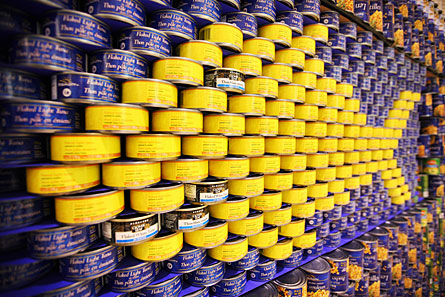The mercury in that tuna
Pinning down how much of the poison is in the fish we buy.
Eating fish can be good for you: It builds the brains of babies and helps the hearts of grown-ups. And eating fish can be bad for you: Fish from around the world swim in waters polluted with mercury, which gets into some fish, which gets into you when you take a bite.
It can be tough to figure out which types of fish — and how much — a person can eat. But with a little reading and good information, a person can still eat fish and be healthy. In recent weeks, researchers have come up with some advice for how to get the fishy benefits and avoid the toxic mercury.
Take tuna as an example. There are many different species of tuna, but grocery stores and restaurants often sell it without specifying which kind. But the amount of mercury tends to vary with the type of tuna. In one of the new studies, researchers studied 100 samples of sushi tuna purchased from grocery stores and restaurants. Jacob Lowenstein, a scientist at Columbia University in New York City, worked on the study. Sushi is a Japanese style of food presentation, usually involving fish that is served raw.
 |
|
Some types of canned tuna contain the amount of mercury that EPA says is concerning, a recent study found. |
| TheGiantVermin/Flickr |
Lowenstein and his colleagues studied the genetic material in the cells of the tuna. They discovered that the tuna came from three types: bigeye, bluefin and yellowfin species. As the scientists expected, bigger fish had more mercury. So tuna that came from yellowfin, the smallest type on average, had less mercury than tuna from bluefin, which are larger.
But the scientists were surprised to discover that restaurant tuna contained more mercury than fish from the grocery store. Worse, yet, restaurant tuna had, on average, more mercury than the maximum amount recommended by the U.S. Environmental Protection Agency, or EPA.
The EPA recommends that fish not contain more than 0.5 parts per million of mercury. The tuna from restaurants had 0.75 parts per million, on average, and some restaurant samples had levels as high as 1 to 2 parts per million. These numbers may seem small, but long term ingestion of even tiny amounts of mercury can lead to heart or nervous-system disease.
As a result of their study, Lowenstein and his colleagues recommend that government “health agencies should consider adding bigeye and bluefin tuna to mercury advisories.” These advisories caution that people, especially pregnant women and young children, should avoid certain types of fish. Mercury is neurotoxic, which means it can injure developing brains.
In another study, scientists from the University of Nevada Las Vegas looked at three kinds of canned tuna: solid-white, chunk-white and chunk-light. On average, light tuna had 0.28 parts per million, which is safely below the EPA’s recommendation.
But solid and chunk-white types averaged 0.5 parts per million, right at the level of concern. The researchers calculated that a 55-pound child can safely eat only one serving every two weeks.
The Nevada scientists recommend that government agencies be stricter about allowable mercury levels in fish. The EPA, the researchers recommend, should produce a clear policy that will tell people how much mercury they can consume — and where it comes from. The scientists would like to see a similar policy from the Food and Drug Administration (FDA). Right now, the FDA safety limit is 1 part per million, or twice that of the EPA.
In a third study, Edward Groth III studied FDA’s database that documents mercury contamination in 51 different types of fish and found that some types have 100 times the amount of mercury typically found in other types. This means there is no easy rule about mercury and fish — it depends on the species of fish and how contaminated the waters were in which it had lived. Groth produced a chart to make it easy for consumers to check the mercury content of the fish they’re about to eat or buy. The chart is small enough for a person’s pocket.
In June, experts from around the world will get together in Stockholm, Sweden, to develop a world policy on mercury. Mercury can come from natural sources, like volcanoes, but it is also pollution produced by industrial sources like coal-fired power plants.
Once mercury gets in the water and into the fish, it can get into you. But in this case, a little information can go a long way in keeping the mercury at bay.
Going Deeper:
Raloff, Janet. 2010. “Studies aim to resolve confusion over mercury risks from fish,” Science News, April 21. http://www.sciencenews.org/view/generic/id/58464/title/Studies_aim_to_resolve__confusion_over_mercury_risks_from_fish
Ramsayer, Kate. 2005. “Cleaning up fish farms,” Science News for Kids, May 11. http://www.sciencenewsforkids.org/articles/20050511/Feature1.asp
Learn all about mercury: http://www.epa.gov/mercury/







